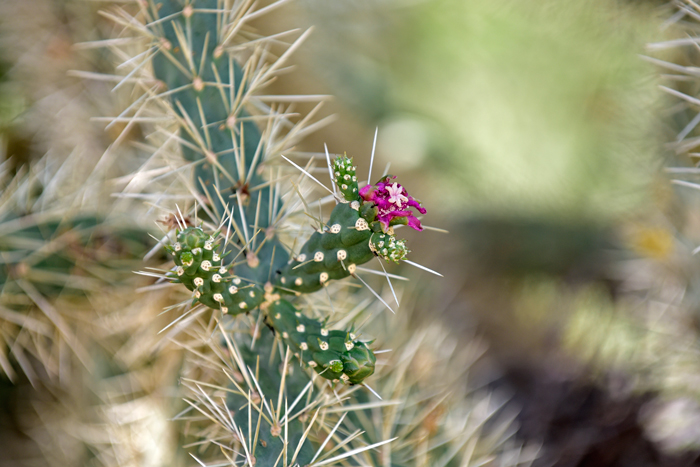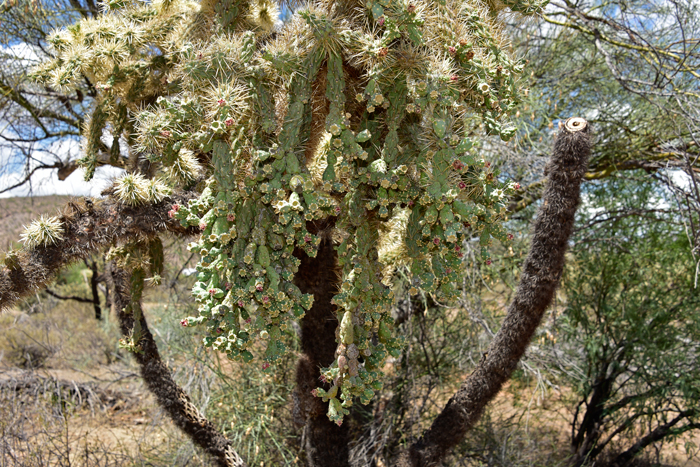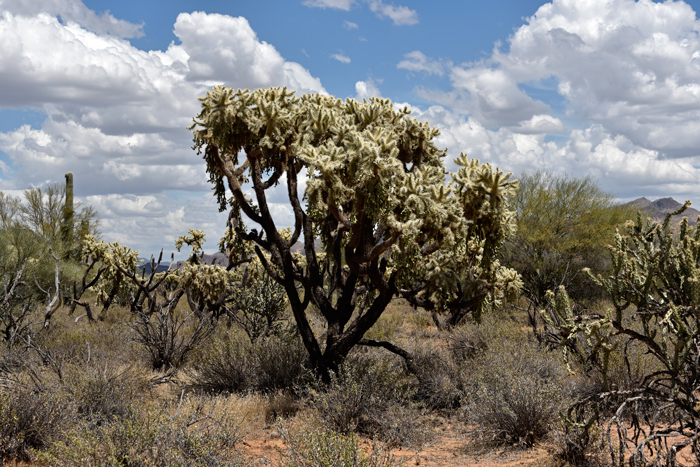Cylindropuntia fulgida, Jumping Cholla




Scientific Name: Cylindropuntia fulgida
Common Name: Jumping Cholla
Also Called: Cholla Brincadora, Chain-fruit Cholla, Hanging Chain Cholla; (Spanish: Choya, Velas de Coyote).
Family: Cactaceae, Cactus Family
Synonyms: (Opuntia fulgida)
Status: Native
Duration: Perennial
Size: Up to 9 feet.
Growth Form: Shrub or tree; trunk divaricately branching; stem segments about 5 inches long, whorled or sub-whorled.
Leaves: Areoles gold to tan maturing gray or black; glochids yellow; spines about one inch long, 0 to 12 per areole, yellowish to brown, whitish sheaths, upper spines erect, basal spines also erect to deflexed.
Flower Color: Pink to magenta inner tepals; flowers open late afternoon; fruits gray green and obconic, fruits fleshy and spine-less, forming long pendulous chains that branch; fruits with viable seeds persist in "chains" for several decades.
Flowering Season: (June) April to September.
Elevation: 500 to 3,600 feet.
Habitat Preferences: Sandy flats, rocky slopes and rolling hillsides.
Recorded Range: Jumping Cholla is found in the southwestern United States in AZ, CA and NM. It is also native to northwestern Mexico.
North America & US County Distribution Map for Cylindropuntia fulgida.
U.S. Weed Information: No information available.
Invasive/Noxious Weed Information: No information available.
Wetland Indicator: No information available.
Threatened/Endangered Information: In Arizona, all varieties of Cylindropuntia fulgida, Jumping Cholla are salvage restricted.
Genus Information: In North America there are 29 species and 39 accepted taxa overall for Cylindropuntia. Worldwide, The Plant List includes 43 accepted species names and a further 100 scientific names of infraspecific rank for the genus.
In the Southwestern United States: Arizona has 12 species of genus, California has 10 species, Nevada has 5 species, New Mexico has 8 species, Texas has 6 species, Utah has 3 species. Hybrids excluded, all data is approximate and subject to taxonomic changes.
There are 2 varieties in Cylindropuntia fulgida, Jumping Cholla;
Cylindropuntia fulgida var. fulgida, Jumping Cholla, (AZ, CA, NM);
Cylindropuntia fulgida var. mamillata, Jumping Cholla, (AZ).
Comments: Although rare, Cylindropuntia fulgida is known to hybridize with Cylindropuntia spinosior and Cylindropuntia leptcaulis in south-central Arizona.
In Southwest Desert Flora also see: Buckhorn Cholla, Cylindropuntia acanthocarpa, Arizona Pencil Cholla, Cylindropuntia arbuscula, Teddy Bear Cholla, Cylindropuntia bigelovii, Gander's Buckhorn Cholla, Cylindropuntia ganderi, Klein's Pencil Cactus, Cylindropuntia kleiniae Christmas Cactus, Cylindropuntia leptocaulis, Walkingstick Cactus, Cylindropuntia spinosior and Baja Pencil Cholla, Cylindropuntia tesajo.
The species epithet fulgida perhaps might mean something "shiny" as referenced from the Latin words fulgeo, fulgo or fulgeo collectively meaning to flash, glitter, shimmer, gleam or shine.
The common name "Jumping Cholla" is a direct reference from the plants detaching stems that easily "jump" off when touched, brushed or otherwise physically disturbed. The stems are able to attach themselves to human clothing and desert roaming mammals.

